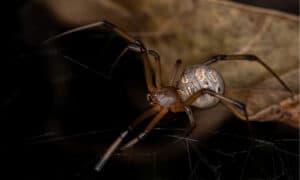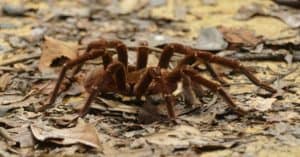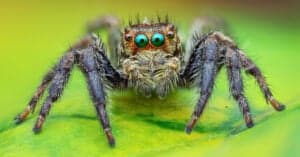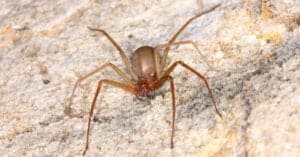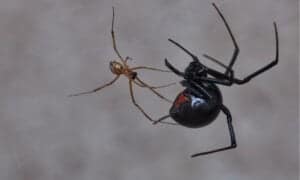Just How Big is the Joro Spider?
@media (min-width: 481px) {
.mobile-top-content {
display: none;
}
}
#mobileTopContentCTACarouselControls { overflow: hidden; text-overflow: ellipsis; white-space: nowrap; }
.mobile-top-content .more { color: #fff; }
.mobile-top-content a { color: #fff; text-decoration: underline; }
.mobile-top-content a:hover { color: #fff; text-decoration: underline; }
@media (max-width: 480px) {
.mobile-top-content {
background-color: #06a10b;
color: #fff;
text-align: center;
/*height: 60px;
padding-top:5px;*/
font-size:80%;
/* display: block; */
margin: 0px -30px;
}
}
The headlines read, “Giant Parachuting Spiders Expected to Invade the East Coast!”. The Joro spider is an invasive spider that has been spreading throughout Georgia and is now in South Carolina as well. A new study from the University of Georgia states that these spiders could colonize all the way up the East Coast.
The research showed that Joro spiders are more resilient to cold climates than orb weaver spiders, another species that is found in Georgia. These spiders use “ballooning”, a technique of creating a parachute-like web to float on the air’s currents. But when they say they are “giant” just how big is the Joro spider?
What is a Joro spider?
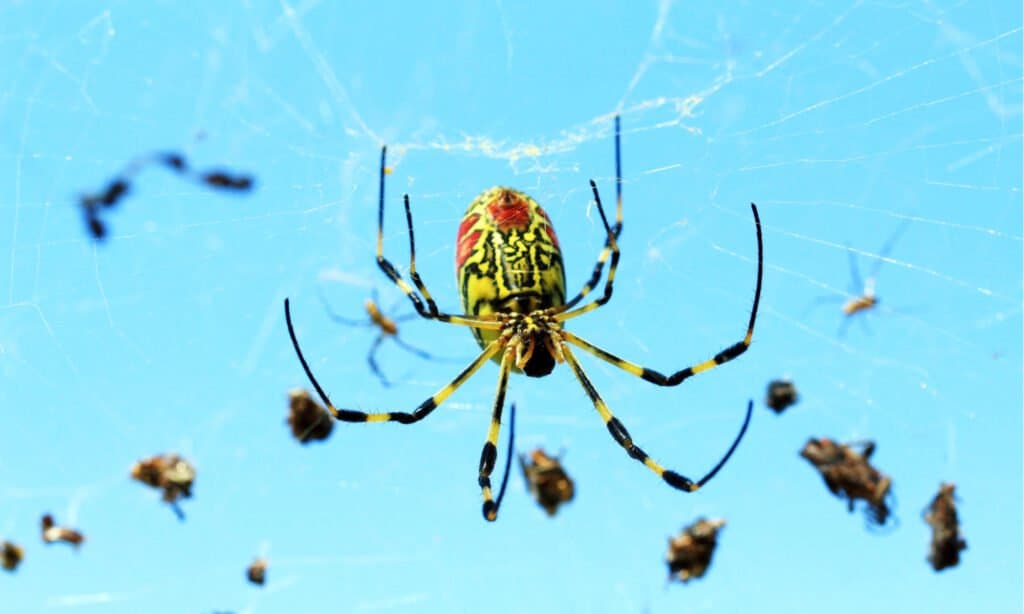
Surapong Kaewsa-ad/Shutterstock.com
Joro spiders (Trichonephila clavate) are a colorful spider that comes from Japan and Korea. They have been identified in the US since 2014, with the first one found in a few counties of Georgia. The female Joro spiders look like a bumblebee with spider legs because they are yellow and black. Most have a red splotch on their back and their underside. The legs are long and skinny with alternating bands of yellow and blue. The male Joro spiders lack the bright colors of the females and most are brown with faint yellow markings.
How big are Joro spiders?
The female Joro spiders can have a leg span of 3-4 inches (7.62 – 10.16 cm)! If one was sitting on top of a full roll of toilet paper their legs could touch the edges. Their bodies are cylindrical and are typically 1 inch long (2.5cm). The females are quite a bit bigger than the males. The male Joro is only ¼ inch (.6 cm) with a leg span of 1-1.5 inches (2.5-3.8 cm). When a female or male is significantly different in size than the other it is called sexual dimorphism.
How do Joro spiders compare to a house spider?
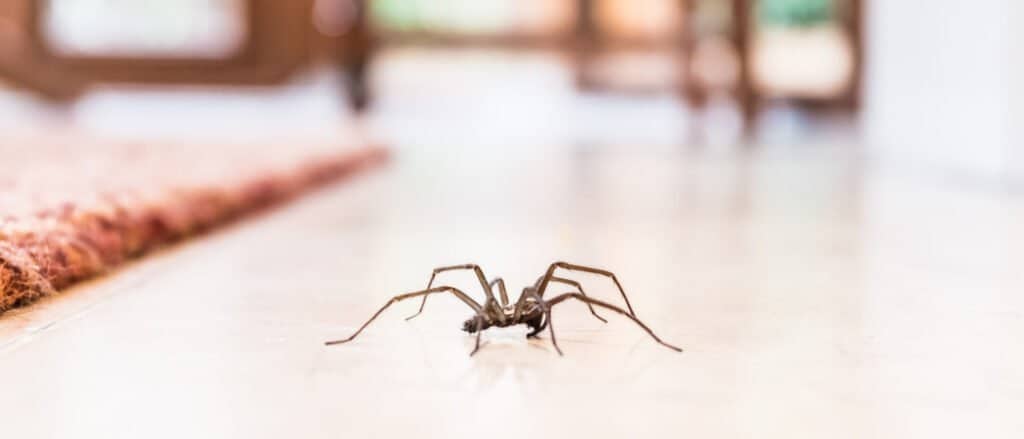
Christine Bird/Shutterstock.com
The common house spider (Parasteatoda tepidariorum) is a small brown spider that makes webs in the corners of basements, attics, garages, etc. They are not colorful at all and only vary in shades of brown to black. The female house spider is about the same size as the male Joro, ¼ inch (.6 cm). The male house spider is even smaller at .15-.19 inches (.4-.5 cm).
How do Joro spiders compare to the top 10 biggest spiders in the world (tarantualas, huntsman spiders, etc)?
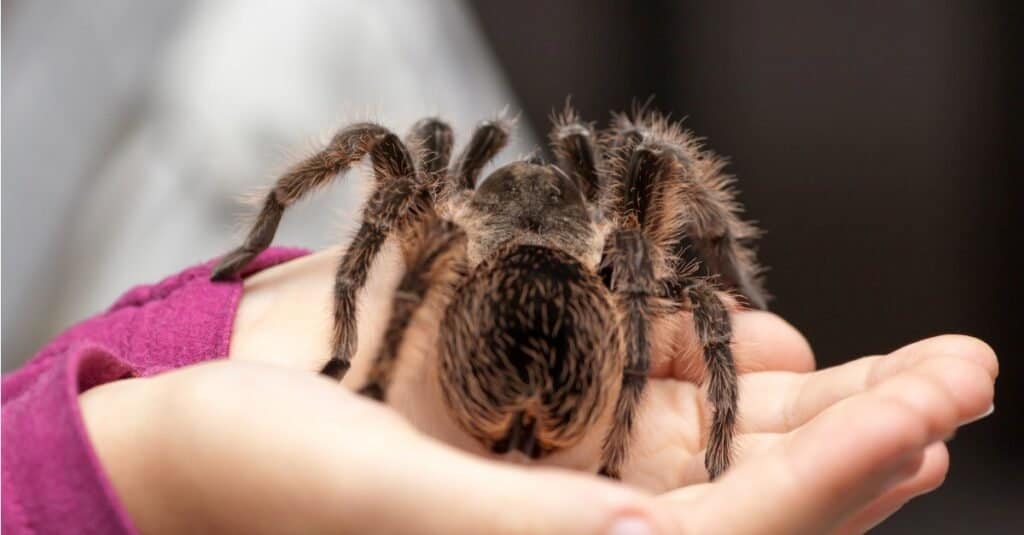
iStock.com/waldru
With a leg span that tops out at about 4 inches at its maximum, Joro spiders are among the largest spiders on Earth, but they don’t reach the top 10 list of largest spiders. Let’s take a look at
10) Cerbalus aravaensis: found in the Arava Valley of Israel and Jordan, leg span of 5.5 inches
9) Brazilian wandering spider: found in Brazil and from Costa Rica to Argentina, leg span of 5.9 inches
8) Camel spider: live in Iran and Irag, leg span of 6 inches
7) Columbian giant redleg spider: found in Columbia and Brazil, leg span of 7 inches
6) Hercules baboon spider: only found one time in Nigeria, it is on display at the London Natural History Museum, leg span of 7.9 inches
5) Face-size tarantula:(How is that for a name!), found in Sri Lanka and India, leg span of 8 inches
4) Brazilian giant tawny red tarantula: found in Brazil, Uruguay, Paraguay and Argentina, leg span of 10 inches
3) Brazilian salmon pink birdeater spider: found in Brazil, Argentina and Paraguay, leg span of 10 inches
2) Goliath bird-eating spider: found in the Amazon rainforest in Surinam, Guyana and French Guiana, leg span of 11 inches
1) Giant huntsman spider: only lives in Laos, was first discovered in 2001, leg span up to 12 inches!!
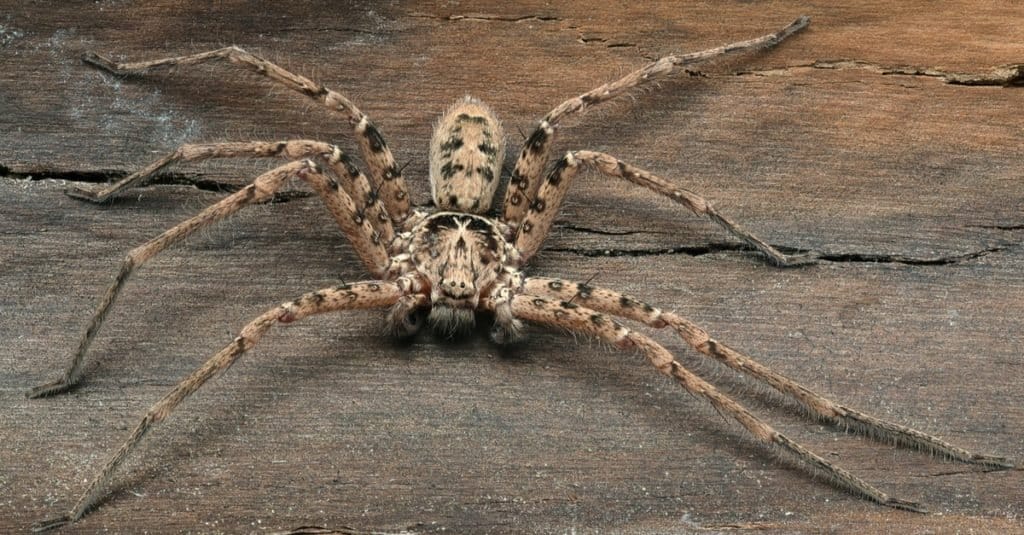
iSKYDANCER/Shutterstock.com
What is the biggest spider ever?
According to the Guinness Book of World Records the “Largest Spider” on record goes to a male goliath bird-eating spider (Theraphosa blondi). Members of the Pablo San Martin Expedition at Rio Cavro, Venezuela found this spider in April 1965. Its leg span was 11 inches, the same as a dinner plate!
As noted above, however, since the Guinness Book of World Records declared the goliath bird-eating spider the largest species, the giant huntsman was discovered in caves in Laos.
Any other giant spiders making headlines?

The Joro spiders are in the news now, but what about other stories of giant spiders? In April of 2004, a group of US soldiers stationed in Iraq emailed a photo of two “giant” camel spiders clinging to each other. It looked like their bodies were at least a foot long each. They included wild claims like they can run 25mph and eat the stomachs of camels. Turns out it was a hoax and the photo was created with a unique positioning of the camera angle making the spiders look much, much bigger than they are. Camel spiders are solpugids and typically have a leg span that can reach up to 6 inches. These spiders are desert spiders that look scorpion-like, but do not get to be a foot long.
How big are Joro spider webs?
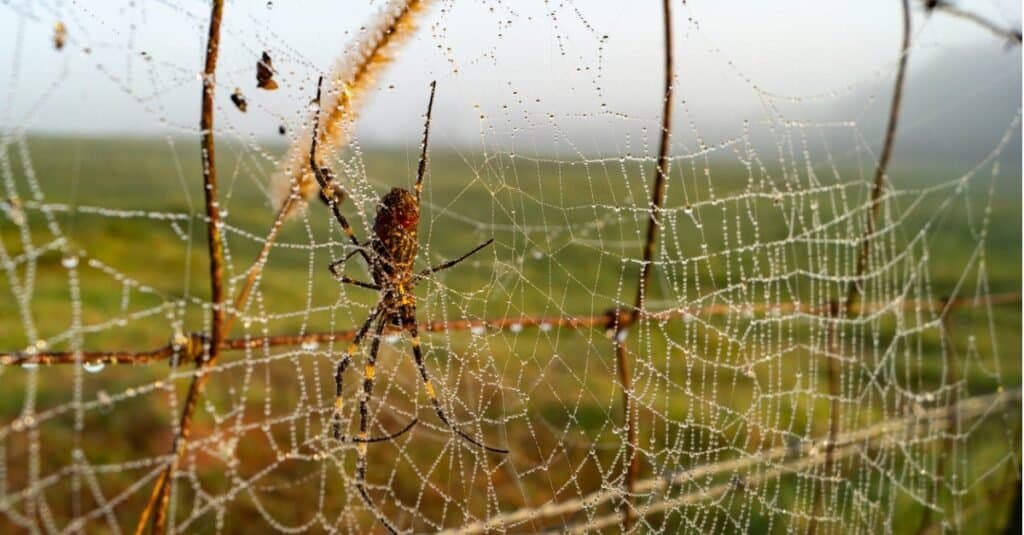
In October 2021 there were a lot of news stories about the Joro spiders invading Georgia with their giant webs everywhere. The Joro spiders hatch from eggs in the spring and then mature over the summer and are fully grown by late summer/fall. This is when they start looking for places to mate and lay their eggs. The female spiders spin elaborate webs that are spherical and three-dimensional.
Like other orb weaver spiders, these webs are spun from golden-colored silk. Georgians were finding massive webs in their gardens, next to their sheds, and higher up in trees and bushes. Some of the webs measured 10 feet wide! The webs may be annoying but Joro spiders are actually great for the garden because they eat a lot of pests like aphids, stink bugs and mosquitoes. So it may be nice to have these giant spiders around.
More from A-Z Animals
.more-snake-card-image { max-height:140px !important; }
@media (min-width: 481px) {
.mobile-top-content {
display: none;
}
}
#mobileTopContentCTACarouselControls { overflow: hidden; text-overflow: ellipsis; white-space: nowrap; }
.mobile-top-content .more { color: #fff; }
.mobile-top-content a { color: #fff; text-decoration: underline; }
.mobile-top-content a:hover { color: #fff; text-decoration: underline; }
@media (max-width: 480px) {
.mobile-top-content {
background-color: #06a10b;
color: #fff;
text-align: center;
/*height: 60px;
padding-top:5px;*/
font-size:80%;
/* display: block; */
margin: 0px -30px;
}
}
The headlines read, “Giant Parachuting Spiders Expected to Invade the East Coast!”. The Joro spider is an invasive spider that has been spreading throughout Georgia and is now in South Carolina as well. A new study from the University of Georgia states that these spiders could colonize all the way up the East Coast.
The research showed that Joro spiders are more resilient to cold climates than orb weaver spiders, another species that is found in Georgia. These spiders use “ballooning”, a technique of creating a parachute-like web to float on the air’s currents. But when they say they are “giant” just how big is the Joro spider?
What is a Joro spider?

Surapong Kaewsa-ad/Shutterstock.com
Joro spiders (Trichonephila clavate) are a colorful spider that comes from Japan and Korea. They have been identified in the US since 2014, with the first one found in a few counties of Georgia. The female Joro spiders look like a bumblebee with spider legs because they are yellow and black. Most have a red splotch on their back and their underside. The legs are long and skinny with alternating bands of yellow and blue. The male Joro spiders lack the bright colors of the females and most are brown with faint yellow markings.
How big are Joro spiders?
The female Joro spiders can have a leg span of 3-4 inches (7.62 – 10.16 cm)! If one was sitting on top of a full roll of toilet paper their legs could touch the edges. Their bodies are cylindrical and are typically 1 inch long (2.5cm). The females are quite a bit bigger than the males. The male Joro is only ¼ inch (.6 cm) with a leg span of 1-1.5 inches (2.5-3.8 cm). When a female or male is significantly different in size than the other it is called sexual dimorphism.
How do Joro spiders compare to a house spider?

Christine Bird/Shutterstock.com
The common house spider (Parasteatoda tepidariorum) is a small brown spider that makes webs in the corners of basements, attics, garages, etc. They are not colorful at all and only vary in shades of brown to black. The female house spider is about the same size as the male Joro, ¼ inch (.6 cm). The male house spider is even smaller at .15-.19 inches (.4-.5 cm).
How do Joro spiders compare to the top 10 biggest spiders in the world (tarantualas, huntsman spiders, etc)?

iStock.com/waldru
With a leg span that tops out at about 4 inches at its maximum, Joro spiders are among the largest spiders on Earth, but they don’t reach the top 10 list of largest spiders. Let’s take a look at
10) Cerbalus aravaensis: found in the Arava Valley of Israel and Jordan, leg span of 5.5 inches
9) Brazilian wandering spider: found in Brazil and from Costa Rica to Argentina, leg span of 5.9 inches
8) Camel spider: live in Iran and Irag, leg span of 6 inches
7) Columbian giant redleg spider: found in Columbia and Brazil, leg span of 7 inches
6) Hercules baboon spider: only found one time in Nigeria, it is on display at the London Natural History Museum, leg span of 7.9 inches
5) Face-size tarantula:(How is that for a name!), found in Sri Lanka and India, leg span of 8 inches
4) Brazilian giant tawny red tarantula: found in Brazil, Uruguay, Paraguay and Argentina, leg span of 10 inches
3) Brazilian salmon pink birdeater spider: found in Brazil, Argentina and Paraguay, leg span of 10 inches
2) Goliath bird-eating spider: found in the Amazon rainforest in Surinam, Guyana and French Guiana, leg span of 11 inches
1) Giant huntsman spider: only lives in Laos, was first discovered in 2001, leg span up to 12 inches!!

iSKYDANCER/Shutterstock.com
What is the biggest spider ever?
According to the Guinness Book of World Records the “Largest Spider” on record goes to a male goliath bird-eating spider (Theraphosa blondi). Members of the Pablo San Martin Expedition at Rio Cavro, Venezuela found this spider in April 1965. Its leg span was 11 inches, the same as a dinner plate!
As noted above, however, since the Guinness Book of World Records declared the goliath bird-eating spider the largest species, the giant huntsman was discovered in caves in Laos.
Any other giant spiders making headlines?

The Joro spiders are in the news now, but what about other stories of giant spiders? In April of 2004, a group of US soldiers stationed in Iraq emailed a photo of two “giant” camel spiders clinging to each other. It looked like their bodies were at least a foot long each. They included wild claims like they can run 25mph and eat the stomachs of camels. Turns out it was a hoax and the photo was created with a unique positioning of the camera angle making the spiders look much, much bigger than they are. Camel spiders are solpugids and typically have a leg span that can reach up to 6 inches. These spiders are desert spiders that look scorpion-like, but do not get to be a foot long.
How big are Joro spider webs?

In October 2021 there were a lot of news stories about the Joro spiders invading Georgia with their giant webs everywhere. The Joro spiders hatch from eggs in the spring and then mature over the summer and are fully grown by late summer/fall. This is when they start looking for places to mate and lay their eggs. The female spiders spin elaborate webs that are spherical and three-dimensional.
Like other orb weaver spiders, these webs are spun from golden-colored silk. Georgians were finding massive webs in their gardens, next to their sheds, and higher up in trees and bushes. Some of the webs measured 10 feet wide! The webs may be annoying but Joro spiders are actually great for the garden because they eat a lot of pests like aphids, stink bugs and mosquitoes. So it may be nice to have these giant spiders around.

